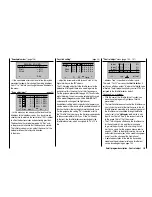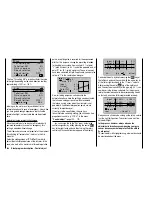
274
Detail program description - Control adjust
In order to now achieve this with the
mx-20
Hott,
switch to the "
Brake settings
" of the …
"Wing mixers" menu
(beginning on page 146)
… and enter the values for the ailerons to be raised
and the "fl aps" to be lowered in the "Crow" line so that
the occurring moments compensate one another and
the altitude of the model remains stable. In the process,
however, you should leave the fl aps with enough "play"
for the elevator function!!! Therefore, do not utilize the
entire servo travel for the crow alone; for example:
Elevat cur ve
BRAKE SETTINGS
AILE
Crow
D.red
+55%
0%
0%
–44%
0%
0%
FLAP FLAP2
Nor mal
You can ignore all other settings in this menu.
Notice:
The "Brake settings" menu is switched "off" if "yes"
is entered for the currently active fl ight phase in the
"
Model type
" menu, page 82, "Motor to C1 front/rear"
and in the "Motor" column of the "
Phase setting
" menu,
page 128. Change the fl ight phase, if applicable.
Similarly, a modern, tapered fl ying wing air craft can
also be operated. With some of these models there
are also interior and exterior rudders: The prior is in
front of the center of gravity and the latter is behind. A
downward throw of the central rudder(s) increases the
ascending forces and has an elevator effect. An upward
throw has the opposite effect. On the exterior ailerons,
on the other hand, the effect is just the opposite: A
downward throw shows an elevator effect and vice
versa. With appropriate adjustment of the "leading"
mixer to the setting of curve mixers in order to achieve a
supporting effect from the external rudder pair with only
extreme joystick defl ection in the height/depth direction,
"everything" is possible here. The author of this manual
uses a curve mixer for his model, which is defi ned by a
total of four points:
0%
0%
Input
Output
Point
C.MIX 9
nor mal
Cur ve
EL
5
0%
on
In this example the two interpolation points 1 and 2
are each at 0 % as well as the left edge point at +60 %
and the right edge point at -65 %. Then the curve was
rounded by pressing the central
SET
key of the right
touch pad.
In this case: Regardless of which type of servo
arrangement was selected, any type of differentiation
should be set with caution! On a tail-less model,
differentiations show a single-sided height/depth
elevator effect, so we urgently recommend beginning
at least the initial fl ights with a setting of 0 %! Over
the course of the further fl ight testing, under certain
circumstances it may be advantageous to experiment
with differentiations deviating from zero.
With larger models, rudders in the winglets - the "ears"
mounted on the wing ends - can be benefi cial. If these
are controlled with two separate servos, with the use of
one of the mixers in the menu ...
"Cross-mixer"
(page 194)
… the rudder signal can be "split" very easily and even
differentiated, whereby the second rudder servo is
connected to one of the still free receiver outputs. For a
model of the type "
Delta/Nf
", the receiver output "5" may
still be free, and we want to use it in the following:
Typ
Diff.
zu
DUAL MIXER
Mixer1
Mixer2
5
RU
Mixer3
Mixer4
??
??
??
??
??
??
0%
0%
0%
+66%
In
this
case a differentiation is necessary, because
the respective exterior rudder fl ies over a larger curve
radius than the interior rudder, which is comparable to
the wheel position of the front wheels of a car when
traveling on curves.
Notice:
The rudder can only be differentiated as programmed
above!
If these two rudders should also defl ect outward on the
actuation of a brake system with the C1 joystick, this
can be achieved, for example, by setting an additional
mixer "
C1
5
" with an appropriate travel setting. Set
the offset according to your habits to "front" (+100 %)
or "rear" (-100 %), because the winglet rudder should
defl ect outward proportionally on extension.
Independently of this, you should, for safety's sake,
uncouple the "false" control function from the control
signal to which the second servo was connected – even
if all inputs are "free" by default in the "
Control adjust
"
menu – through the
fl ight-independent
menu …
Summary of Contents for mx-20 Hott
Page 41: ...41 Your notes...
Page 49: ...49 Your notes...
Page 55: ...55 Your notes...
Page 81: ...81 Your notes...
Page 85: ...85 Your notes...
Page 89: ...89 Your notes...
Page 99: ...99 Detail program description Control adjust...
Page 127: ...127 Detail program description Control adjust...
Page 131: ...131 Detail program description Control adjust...
Page 163: ...163 Detail program description Control adjust...
Page 191: ...191 Detail program description Control adjust...
Page 207: ...207 Detail program description Control adjust...
Page 228: ...228 Detail program description Control adjust...
Page 229: ...229 Detail program description Control adjust...
Page 251: ...251 Detail program description Control adjust...
















































